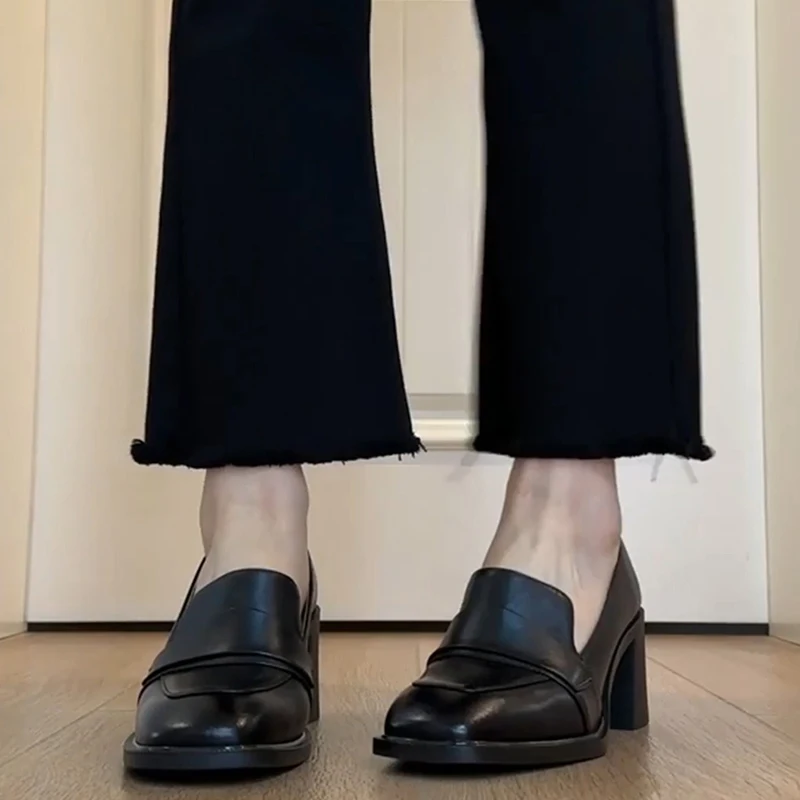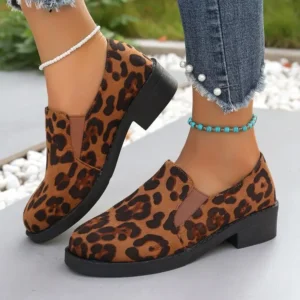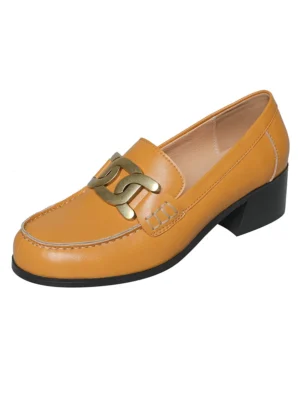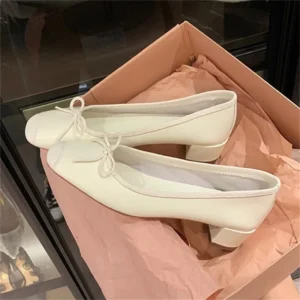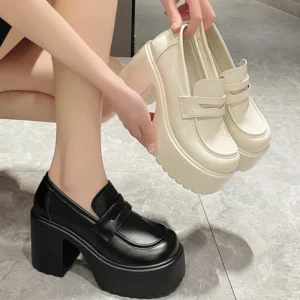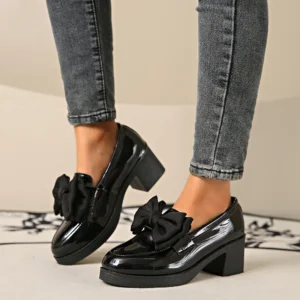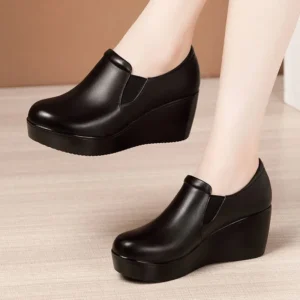Introduction: Why Square Heeled Structured Shoes Are Transforming Office Footwear
The modern professional wardrobe has evolved significantly in recent years, with square heeled structured shoes emerging as a game-changer in office footwear. These distinctive shoes feature a squared-off heel base rather than a tapered or round one, paired with a non-collapsible upper that maintains its shape throughout the workday. Unlike their stiletto counterparts, square heeled shoes offer the perfect trifecta: sophisticated style, remarkable stability, and all-day comfort.
For career-minded individuals spending long hours on their feet, these architectural wonders provide reduced foot fatigue, improved posture, and seamless integration with professional attire. Their structured design supports the foot properly while the square heel distributes weight more evenly, making them ideal companions for demanding workdays.
The versatility of square heeled structured shoes has made them increasingly popular among those seeking to combine professional office loafer outfits with practical comfort. Whether paired with tailored suits, pencil skirts, or smart casual ensembles, these shoes maintain their elegant profile while providing the support needed for workplace productivity.
This guide will walk you through everything you need to know about selecting, styling, and maintaining the perfect square heeled shoes for your professional environment, helping you navigate the ultimate guide to women’s loafers for office wear with confidence and sophistication.
What Makes Square Heels Ideal for Professional Environments?
Square heels have earned their place in professional wardrobes for several compelling reasons that go beyond mere aesthetics. Their distinctive geometric shape offers practical advantages that make them particularly suitable for office environments.
Superior Stability and Balance
Unlike stilettos that concentrate pressure on a tiny contact point, square heels distribute weight across a wider base. This structural advantage translates to significantly improved stability—reducing the risk of wobbling or ankle turns while navigating office hallways, stairs, or urban commutes. Many professionals find that block heels are good for feet health precisely because of this improved stability.
Professional Aesthetic Appeal
The clean lines and architectural presence of square heels project confidence and competence. Their geometric precision complements structured business attire perfectly, creating a cohesive professional appearance that works equally well with traditional suits or contemporary office ensembles.
Comfort Benefits for All-Day Wear
Square heels offer these key comfort advantages:
– More even weight distribution across the foot
– Reduced pressure on the ball of the foot
– Greater stability when standing for extended periods
– Less muscle fatigue in calves and feet
Noise Consideration
The broader base of square heels typically produces less clicking and clacking on hard surfaces—an underappreciated benefit in quiet office environments where the sharp tap of stilettos might be distracting.
Modern Functionality
Square heels represent the perfect marriage of style and function—they offer the elevated, polished look expected in professional settings while providing practical benefits that support productivity throughout demanding workdays.
The Anatomy of Properly Structured Office Shoes
Understanding what makes a truly “structured” shoe is essential when investing in quality office footwear. In footwear terminology, “structured” refers to shoes that maintain their intended shape, provide adequate support, and resist collapsing or deforming with regular wear. This quality is particularly important for professional environments where both appearance and comfort matter greatly.
Key Components of Structured Office Shoes
Reinforced Heel Counter: The semi-rigid component at the back of the shoe that cups the heel. A properly structured heel counter maintains its shape, prevents the heel from slipping, and provides crucial stability. Quality shoes feature heel counters made from molded leather or high-grade synthetics that retain their shape throughout years of wear.
Structured Toe Box: The front section that houses your toes should offer adequate space while maintaining its shape. Neither too rigid (causing discomfort) nor too soft (losing professional appearance), the ideal structured toe box protects the foot while preserving the shoe’s elegant silhouette.
Supportive Midfoot: The arch area between heel and ball of foot requires proper structure to prevent foot fatigue during long workdays. This often includes internal shanks (metal, fiberglass, or plastic supports) that prevent the shoe from twisting and provide crucial arch support.
Quality Upper Materials: Full-grain leather, premium calf leather, and high-quality structured synthetics contribute significantly to a shoe’s ability to maintain its professional appearance. These materials conform to the foot without losing their essential shape or developing unsightly creases.
Our women’s block heel loafers collection exemplifies these structural elements perfectly, providing the support needed for professional environments while maintaining sophisticated style.
The importance of properly structured footwear becomes most apparent during extended wear. During an 8+ hour workday, inadequately structured shoes begin to collapse, leading to poor foot alignment, increased fatigue, and accelerated wear. Investing in well-structured office shoes pays dividends in both comfort and professional appearance.
Top Materials for Durable and Professional Square Heeled Shoes
The materials used in square heeled structured shoes significantly impact their durability, comfort, professional appearance, and overall value. Understanding these options helps you make informed decisions when investing in office footwear.
Premium Leather Options
Full-grain Leather: The highest quality leather option, featuring the complete grain of the hide with all natural markings. Full-grain leather:
– Develops a beautiful patina over time
– Offers exceptional durability for years of professional wear
– Provides breathability for all-day comfort
– Projects a refined, prestigious appearance
Patent Leather: With its high-gloss finish, patent leather brings:
– Sophisticated sheen perfect for formal office environments
– Excellent resistance to water spots and stains
– A structured appearance that maintains its shape
– Easy cleaning with simple wiping
Nubuck: A sanded or buffed leather with a velvety surface that:
– Offers subtle elegance for professional settings
– Provides durability with a softer visual texture
– Requires protective treatment to maintain appearance
High-Quality Synthetic Alternatives
Modern synthetic materials have advanced significantly, offering viable alternatives when:
– Specific weather resistance is needed
– Budget considerations are paramount
– Certain textures or finishes are desired
– Non-animal materials are preferred
Interior Lining Considerations
The interior materials directly affect all-day comfort:
– Leather linings: Offer breathability and mold to your foot shape
– Moisture-wicking synthetics: Provide comfort in various temperatures
– Cushioned insoles: Essential for extended standing or walking
Sole Materials for Professional Settings
Leather Soles: Traditionally professional with a refined appearance, though less slip-resistant and durable than modern alternatives.
Rubber Soles: Provide excellent grip and durability while significantly reducing noise—particularly valuable in quiet office environments.
Composite Soles: Combine leather appearance with rubber inserts, offering both professional aesthetics and practical functionality.
Our women’s leather heeled loafers showcase these premium materials, demonstrating how quality construction contributes to both professional appearance and lasting comfort.
Finding Your Perfect Heel Height: Balancing Comfort and Style
Selecting the optimal heel height for professional square heeled shoes requires balancing style preferences with practical workplace demands. The ideal height varies based on your specific role, workplace culture, and personal comfort needs.
Professional Heel Height Guide
| Heel Height | Measurement | Best For | Professional Setting |
|---|---|---|---|
| Low | 1-1.5 inches (2.5-3.8 cm) | All-day comfort, significant walking, conservative offices | Traditional corporate, banking, law, government |
| Medium | 1.75-2.5 inches (4.4-6.3 cm) | Balance of elevation and comfort, moderate walking | Business casual environments, creative corporate, education |
| High | 2.75-3 inches (7-7.6 cm) | Maximum elevation, primarily sitting roles | Fashion-forward offices, brief presentations, special occasions |
Factors Influencing Your Optimal Height
Daily Movement Requirements: Consider how much walking and standing your role demands. Roles requiring frequent movement between meetings or departments benefit from lower heights, while desk-focused positions allow for taller options.
Standing Duration: If your position involves extended periods of standing (presentations, retail management, event coordination), prioritize lower heights that distribute weight more evenly.
Square Heel Width Considerations: The width of your square heel directly impacts stability—wider bases provide better balance and comfort, particularly important for higher heels. For maximum workday comfort, choose a heel width proportionate to its height.
Workplace Culture: Observe the typical footwear in your specific work environment. Some traditional professional settings have unwritten expectations about appropriate heel heights, while creative industries often allow greater freedom.
Our women’s low heel loafers provide excellent options for those prioritizing all-day comfort without sacrificing professional appearance.
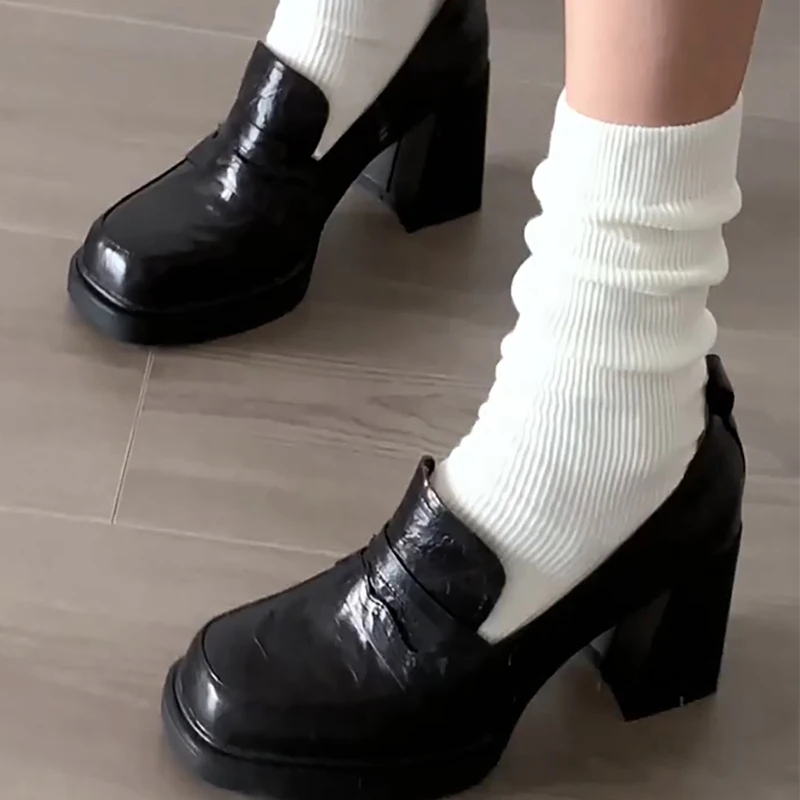
The Most Versatile Square Heeled Styles for Office Environments
When building a professional footwear collection, versatility is key. These square heeled styles offer the perfect balance of professionalism, comfort, and adaptability for various office environments.
Classic Pumps with Square Heels
The quintessential office shoe reimagined with a square heel offers unparalleled versatility. With a closed toe and streamlined silhouette, these pumps:
– Seamlessly transition between suits, skirts, and tailored pants
– Project authority in client meetings and presentations
– Provide a refined profile that works across seasons
– Offer the most traditional professional appearance
Square Heeled Loafers
The marriage of loafer styling with square heels creates a perfect business casual option. These sophisticated hybrids:
– Blend traditional menswear influences with modern feminine touches
– Provide exceptional comfort during long workdays
– Create polished yet approachable professional looks
– Work beautifully with business casual loafer outfits from trousers to modest dresses
Slingbacks with Square Heels
For seasons when more breathable options are appropriate, slingback styles with square heels offer:
– Professional appearance with temperature versatility
– Secure fit that stays in place while walking
– Modern profile that complements both classic and contemporary wardrobes
– Elegant transition from office to after-work events
Ankle Boots with Structured Square Heels
When cooler weather arrives, structured ankle boots with square heels provide:
– Seasonal appropriateness without sacrificing professionalism
– Additional ankle support for commutes in inclement weather
– Versatility with tights, trousers, and longer skirts
– Sophisticated profile that elevates winter workwear
Mary Janes with Square Heels
These retro-inspired yet surprisingly versatile options feature:
– Secure strap design that eliminates slipping during busy days
– Distinctive style that balances professionalism with personality
– Comfortable fit for extended wear
– Vintage-modern aesthetic that complements structured office attire
How to Assess Quality and Construction in Office Footwear
Investing in quality office footwear means understanding the hallmarks of superior construction. These indicators help ensure your professional shoes provide lasting value and maintain their appearance through countless workdays.
Visual Quality Indicators
Stitching Evaluation: Examine the stitching carefully for these signs of quality:
– Even, tight stitches of consistent size
– No loose threads, skipped stitches, or irregular patterns
– Reinforced stitching at stress points
– Clean finishing where materials meet
Sole Attachment: The method used to connect the upper to the sole significantly impacts durability:
– Goodyear welt construction: The gold standard, allowing for resoling and excellent longevity
– Blake stitch method: Sleeker profile while maintaining quality attachment
– Cemented construction: Less durable but can still provide quality if well-executed
Interior Finishing: Quality shoes feature:
– Smooth interior seams that won’t cause discomfort
– Fully lined interiors with no exposed rough edges
– Properly cushioned insoles secured firmly in place
– Reinforced stress points that prevent premature wear
Hands-On Quality Assessment
When examining shoes in person, perform these simple tests:
– Flex test: Bend the sole gently to ensure it offers both flexibility and structure
– Twist test: Attempt to twist the shoe—quality footwear resists excessive torsion
– Heel test: Press on the heel counter to verify it maintains its shape
– Weight evaluation: Quality materials generally have substantive weight
Manufacturing Methods That Indicate Quality
Different construction techniques signal varying levels of quality and durability:
– Hand-stitched components typically indicate premium craftsmanship
– Machine-stitched seams should be precise and even
– Combination methods often provide the best balance of durability and refined appearance
Our women’s black heeled loafers collection demonstrates these quality construction elements, ensuring professional footwear that maintains its appearance and comfort through extended wear.
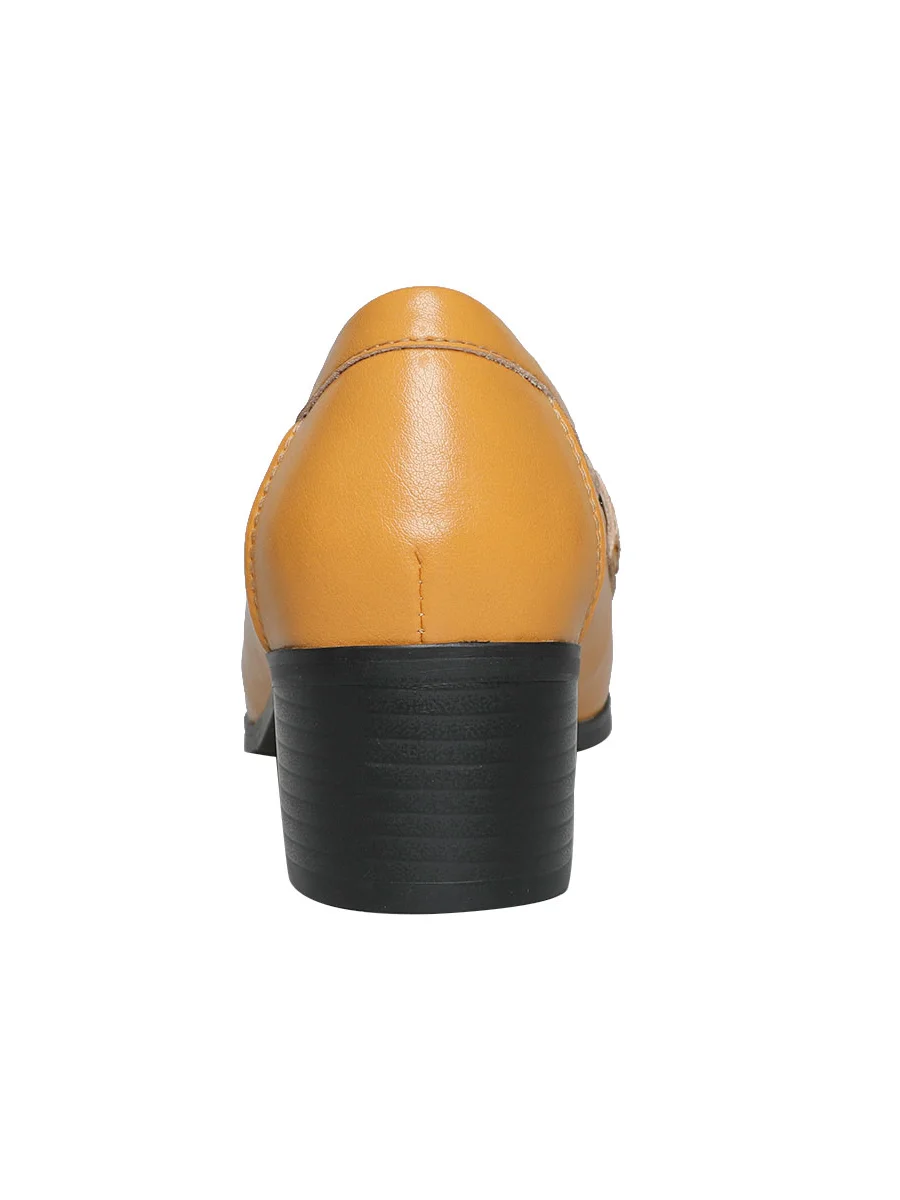
Investing Wisely: Price Points and Value Considerations
When it comes to professional footwear, understanding the relationship between price and value helps you make strategic investments that serve your career and comfort effectively.
Entry-Level Quality Square Heeled Shoes ($100-$150)
At this price point, you can expect:
– Decent synthetic materials or lower-grade leather
– Adequate construction for light to moderate office use
– Basic comfort features suitable for limited walking/standing
– Fashionable designs that may prioritize appearance over longevity
These options work well for:
– Early career professionals building their initial wardrobe
– Secondary options to complement higher-quality staples
– Roles with limited public-facing requirements
– Trying new styles before investing in premium versions
Mid-Range Professional Footwear ($150-$250)
This sweet spot offers significant improvements:
– Full-grain or top-grain leather uppers
– Enhanced construction techniques for durability
– Superior comfort features including better cushioning
– More refined finishing details and craftsmanship
Mid-range shoes provide excellent value for:
– Daily workwear in standard professional environments
– Primary rotation pieces for most career stages
– Balance of appearance and functional longevity
– Versatile styles that transition between settings
Premium Office Footwear ($250+)
Investment-level professional footwear features:
– Exceptional materials throughout (premium leathers, high-grade components)
– Superior construction methods (Goodyear welting, hand finishing)
– Advanced comfort technology and anatomical design
– Distinctive design elements and impeccable detailing
These premium options justify their cost for:
– Client-facing executive positions
– Specialized professional needs (extended standing, travel)
– Career staples worn multiple times weekly
– Roles where impeccable presentation directly impacts outcomes
Cost-Per-Wear Analysis
Rather than focusing solely on purchase price, consider how frequently you’ll wear the shoes and their expected lifespan. A $300 pair worn weekly for three years (approximately 150 wears) costs just $2 per wear—often less than more affordable options that require replacement after a single season.
Women's Comfortable Flat Loafers, Women's Leopard Print Loafers, Women's Low Heel Loafers
$82.50 Select options This product has multiple variants. The options may be chosen on the product pageWomen's Block Heel Loafers, Women's Heeled Penny Loafers, Women's Monk Strap Loafers
$194.04 Select options This product has multiple variants. The options may be chosen on the product pageWomen's Block Heel Loafers, Women's Square Heel Loafers, Women's Square Toe Flat Loafers
Price range: $73.61 through $86.41 Select options This product has multiple variants. The options may be chosen on the product pageWomen's Black Platform Loafers, Women's High Heel Loafers, Women's High Platform Loafers, Women's White Platform Loafers
$106.67 Select options This product has multiple variants. The options may be chosen on the product pageWomen's Black Heeled Loafers, Women's Black Platform Loafers, Women's Block Heel Loafers, Women's Chunky Heel Loafers
$72.58 Select options This product has multiple variants. The options may be chosen on the product pageWomen's High Platform Loafers, Women's Wedge Heel Loafers
$171.07 Select options This product has multiple variants. The options may be chosen on the product page
Our women’s heeled loafers collection spans these price categories, offering options that align with various professional needs and investment levels.
Ensuring Perfect Fit: Sizing and Comfort Considerations
The perfect fit is non-negotiable for professional footwear you’ll wear throughout demanding workdays. Even the most beautifully designed square heeled shoes will remain unworn if they cause discomfort.
Professional Fitting Guidance
For optimal fit in structured professional shoes:
– Shop later in the day when feet are naturally slightly swollen
– Wear the type of hosiery you’ll typically pair with the shoes
– Stand and walk on hard surfaces, not just carpeted store floors
– Ensure adequate toe room without slippage at the heel
– Pay attention to width as well as length for proper fit
Accurate Foot Measurement Techniques
Rather than relying solely on your “usual size”:
– Have both feet measured professionally when possible
– Measure both length and width, as many foot problems stem from incorrect width
– Remember that sizes vary significantly between manufacturers
– Consider having custom insoles made if you have specific foot needs
Addressing Common Fit Issues
For Wider Feet: Look for brands offering wider widths or naturally wider toe boxes while maintaining professional appearance.
For Narrow Heels: Consider styles with ankle straps, slingbacks, or models specifically designed to prevent heel slippage.
For Bunions or Hammer Toes: Seek softer leather uppers that will conform to foot irregularities, or styles with strategic stretch panels.
For High Arches: Ensure adequate instep height and consider adding supportive insoles.
Breaking-In Period Expectations
Quality structured shoes typically require some breaking-in time:
– Start with 2-3 hours of wear before committing to full days
– Use leather conditioning products to soften stiff areas
– Consider professional stretching for targeted problem spots
– Protect potential blister areas with preventative bandages initially
Understanding how square heel design optimizes foot alignment can help you select styles that work in harmony with your foot’s natural structure, enhancing comfort throughout long professional days.
Styling Square Heeled Structured Shoes for Different Office Dress Codes
Mastering the art of integrating square heeled shoes into various professional wardrobes requires understanding both dress code nuances and style principles. These versatile shoes can adapt to environments ranging from strictly formal to creative professional.
For Formal Business Environments
In conservative settings like law, finance, or traditional corporate offices:
– Pair classic black or navy square heeled pumps with tailored suits
– Choose closed-toe styles with moderate (1.5-2 inch) heel heights
– Opt for minimal ornamentation and classic silhouettes
– Ensure impeccable maintenance and polishing
– Coordinate shoe color with other leather accessories
For Business Casual Settings
In moderately formal environments with flexible dress codes:
– Incorporate square heeled loafers with tailored trousers and quality knitwear
– Experiment with deep colors beyond basic black (burgundy, forest green, navy)
– Consider textured leathers for visual interest while maintaining professionalism
– Pair with structured dresses and subtle hosiery
– Use shoes to add personality while respecting workplace norms
For Creative Professional Environments
In design firms, media companies, or other creative workplaces:
– Express more personality through unique square heel designs
– Consider statement colors that complement your professional wardrobe
– Mix textures and materials while maintaining a structured silhouette
– Create signature looks pairing distinctive square heeled shoes with consistent elements
– Balance bolder shoe choices with more conservative apparel (or vice versa)
Seasonal Adaptations
Spring/Summer: Lighter colors, slingback styles, breathable leathers
Fall/Winter: Richer tones, ankle boots, suede textures
Year-Round Options: Black, navy, and neutral square heels in closed styles
Understanding how to wear loafers in the office and the differences between loafers versus heels for professional footwear can expand your styling possibilities while maintaining workplace appropriateness.
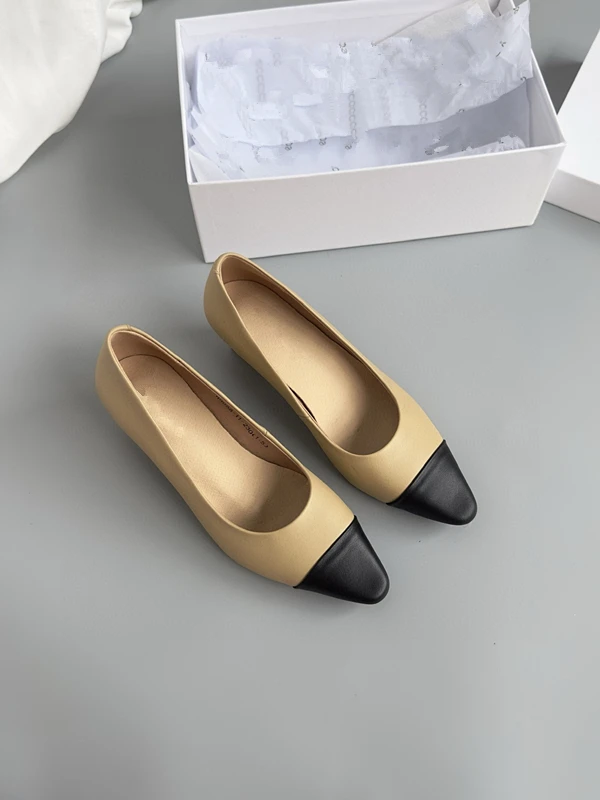
Extending Longevity: Care and Maintenance Best Practices
Proper care dramatically extends the life of your professional footwear, protecting your investment and ensuring your square heeled structured shoes maintain their polished appearance through years of workplace wear.
Daily Maintenance Habits
Implement these simple routines to prevent premature wear:
– Wipe shoes with a soft cloth after each wearing to remove dust and surface dirt
– Use cedar shoe trees to absorb moisture and maintain shape when not worn
– Allow 24-48 hours between wearings to fully dry and recover
– Inspect regularly for early signs of wear that require attention
– Remove salt stains immediately, especially during winter months
Material-Specific Cleaning Protocols
Smooth Leather:
1. Wipe with a slightly damp cloth
2. Apply quality leather conditioner quarterly
3. Polish with matching cream or wax polish
4. Buff to desired shine with soft cloth
Suede or Nubuck:
1. Brush gently with a specialized suede brush
2. Use a protective spray designed for suede
3. Address stains with a suede eraser or specialized cleaner
4. Never apply water or regular leather products
Patent Leather:
1. Wipe with a soft cloth dampened with mild soap solution
2. Apply specialized patent leather restorer for shine
3. Remove scuffs with petroleum jelly on a soft cloth
4. Avoid alcohol-based products which can damage finish
Professional Structure Maintenance
To maintain the structured integrity essential for professional appearance:
– Store shoes with supportive shoe trees inserted
– Use a proper shoehorn to prevent heel counter damage
– Transport in protective bags or compartments when traveling
– Address loose heels or sole separation immediately
– Consider protective sole additions before wearing new shoes
Preventative Care Schedule
For maximum longevity, establish this care routine:
– Daily: Quick wipe-down and insertion of shoe trees
– Weekly: Thorough cleaning and inspection
– Monthly: Conditioning and polishing
– Seasonally: Deep cleaning and preventative treatments
– Annually: Professional assessment for resoling or repair needs
Using the right best products for loafer care ensures your square heeled shoes remain office-ready through countless meetings, presentations, and workdays.
Are Square Heels Suitable for My Specific Workplace?
Determining whether square heeled structured shoes align with your particular professional environment requires considering both explicit dress codes and implicit workplace norms.
Conservative Professional Environments
In traditional law firms, financial institutions, and corporate headquarters:
– Square heels in modest heights (1.5-2 inches) are generally appropriate
– Classic colors (black, navy, nude) in leather finishes maintain formality
– Closed-toe designs without excessive ornamentation ensure compliance
– Square heels on pumps or structured loafers provide the most versatile options
Healthcare and Education Settings
For professionals in medical facilities or educational institutions:
– Square heels provide necessary stability for active roles
– Lower heights accommodate extended standing and walking
– Quieter heel designs minimize disruption in sensitive environments
– Practical considerations like easy cleaning may influence material choices
Creative and Technology Fields
In design agencies, media companies, and tech firms:
– Greater flexibility allows for more expressive square heel designs
– Various colors, textures, and heel heights can align with creative cultures
– Professional appearance still matters, but interpretation is more individual
– Personal style expression through footwear is often encouraged
Client-Facing Considerations
When regularly meeting with external clients or stakeholders:
– Match your footwear formality to client expectations, not just internal norms
– Consider industry-specific standards of your clients’ organizations
– Have versatile options available for varying meeting contexts
– Remember that square heels project stability and confidence in presentations
Learning whether loafers can be worn in business professional settings can help you understand how square heeled versions might integrate into formal workplace environments.
How Do Square Heels Compare to Other Professional Heel Types?
Understanding how square heels stack up against other common professional heel styles helps you make informed footwear choices for different workplace scenarios.
Comparative Analysis of Professional Heel Types
| Heel Type | Stability | Formality Level | Comfort | Style Character |
|---|---|---|---|---|
| Square | Excellent | Business to Business Casual | High | Modern, architectural |
| Block | Very Good | Business to Business Casual | High | Contemporary, substantial |
| Stiletto | Poor | Formal to Business | Low | Traditional, elegant |
| Kitten | Moderate | Formal to Business | Moderate | Classic, feminine |
| Wedge | Excellent | Business Casual | Very High | Casual, practical |
Square vs. Stiletto Heels
Square heels offer significantly better stability and weight distribution compared to stilettos, making them superior for full workdays. While stilettos create a classic elegant look, their practical limitations (discomfort, noise, instability) make them less suitable for active professional roles.
Square vs. Block Heels
These close cousins share many advantages, with square heels featuring crisp geometric edges compared to block heels’ rounded corners. Our ultimate guide to block heel loafers explains these subtle distinctions that can influence your professional appearance. Generally, square heels project a slightly more architectural, modern aesthetic.
Square vs. Kitten Heels
While kitten heels offer delicate femininity and traditional professional appeal, their smaller surface area provides less stability than square options. Square heels deliver similar formality with superior support during long meetings or presentations.
Square vs. Wedge Heels
Wedges offer maximum stability but often project a more casual appearance that may not suit formal environments. Square heels bridge this gap—providing excellent stability while maintaining appropriate business formality.
Can Square Heeled Shoes Address Common Office Footwear Problems?
Square heeled structured shoes offer practical solutions to many challenges professionals face with workplace footwear.
Conquering Foot Fatigue
Long meetings, presentations, and workdays can take a toll on your feet. Square heeled shoes help by:
– Distributing weight more evenly across the foot
– Providing a stable base that reduces muscle strain
– Offering proper arch support in structured designs
– Minimizing the extreme angle that causes forefoot pain
Balancing Professional Appearance with Foot Health
For professionals managing bunions, plantar fasciitis, or other foot conditions:
– Square heeled designs offer more interior volume for custom orthotics
– Their wider base reduces pronation issues common with narrower heels
– The structured design provides support without compromising appearance
– Moderate heights maintain professionalism while reducing foot strain
Commute-to-Office Transitions
Square heeled shoes excel at bridging the gap between commuting and workplace needs:
– Stability makes them suitable for public transportation navigation
– Their comfort allows for walking portions of commutes without changing shoes
– Structured designs withstand daily transportation wear better than delicate styles
– Weather-resistant options maintain professional appearance through varied conditions
Seasonal Adaptations
Square heeled shoes address seasonal challenges through:
– Summer: Breathable leather options and slingback designs for heat
– Winter: Ankle boot versions that accommodate thicker socks
– Rainy Seasons: Water-resistant materials and treatments
– Transition Weather: Versatile closed designs that work year-round
What Should I Look for When Shopping Online for Office Footwear?
The convenience of online shopping comes with unique challenges when purchasing professional footwear. These strategies help ensure successful square heeled shoe purchases without in-person try-ons.
Decoding Product Descriptions
When evaluating online listings, pay special attention to:
✓ Material specifications – Look for detailed descriptions of both upper and lining materials
✓ Construction method – Quality listings will mention how the shoe is assembled
✓ Heel measurements – Both height and width/base dimensions matter for comfort
✓ Fit guidance – Notes about running true to size, narrow, or wide
✓ Weight – Heavier shoes often indicate substantial construction
✓ Interior features – Padding, cushioning, and support elements
Understanding Return Policies
Before purchasing professional footwear online:
– Verify free return shipping for unworn shoes
– Check the return window timeframe (longer is better)
– Understand condition requirements (some allow brief indoor try-on)
– Look for “easy returns” with prepaid labels
– Confirm whether returns process as refunds or store credit
Extracting Value from Customer Reviews
When reading reviews, focus on:
– Comments about fit from customers with similar foot characteristics
– Durability observations from long-term wearers
– Comfort reports specifically about all-day professional wear
– Mentions of break-in periods and how the shoes adapted
– Photos posted by actual customers showing real-world appearance
Accurate Home Measurement Techniques
To determine your size accurately:
1. Trace your foot while standing with weight evenly distributed
2. Measure the length from heel to longest toe
3. Measure the width at the widest part of your foot
4. Compare to the brand’s specific size chart (not universal sizing)
5. Consider measuring late in the day when feet are naturally larger
Finding Balance: When to Prioritize Style vs. Practicality in Office Footwear
Creating a professional footwear collection requires thoughtful consideration of when to emphasize style and when to prioritize practical functionality.
Career Stage Considerations
Early Career Professionals:
– Invest in versatile, comfortable square heeled options that work across multiple settings
– Focus on classic styles that won’t quickly appear dated
– Consider cost-per-wear when building your initial professional wardrobe
– Prioritize shoes that transition well between interview, everyday, and presentation settings
Established Professionals:
– Expand your collection with more specialized pieces for specific functions
– Invest in premium materials and construction as your budget allows
– Consider signature styles that enhance your professional brand
– Balance statement pieces with reliable workhorses
Role-Specific Footwear Needs
Client-Facing Positions: Emphasize refined appearance and current styling that projects competence and attention to detail.
Internal-Focused Roles: Prioritize all-day comfort and durability for consistent office wear.
Leadership Positions: Invest in quality pieces that subtly communicate authority and confidence.
Hybrid Roles: Select versatile options that adapt to varying levels of formality as needed.
Building a Professional Footwear Collection
The foundation of a well-considered office shoe collection includes:
– 1-2 pairs of classic black square heeled shoes (varied heights)
– 1 pair in a versatile neutral that complements your wardrobe palette
– 1 pair of seasonal structured shoes (boots, open styles)
– 1 statement pair that expresses personality while maintaining professionalism
The most effective approach balances timeless professional appeal with thoughtfully selected trend elements that keep your workplace appearance current without appearing faddish. This balanced strategy ensures your square heeled structured shoes serve both your career advancement and personal comfort needs effectively.

